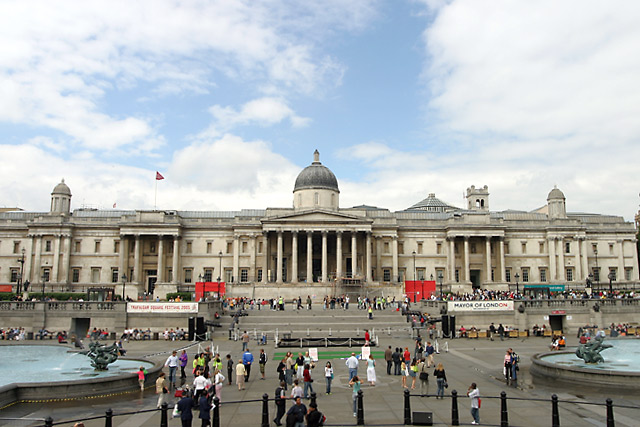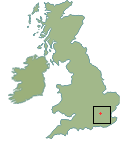Trafalgar Square
Trafalgar Square presents itself as a busy microcosm of London where you'll see the best and the worst of what London has to offer. In the busy intersection, red buses, London cabs, sightseers, theatre-goers, bobbies and city-siders all cross paths in seeming total oblivion to each other. With so much going on, it is a highly entertaining place to be at any time of the day or night.
Even the most culturally obtuse can not fail to be impressed by the grandiose architecture of the square. It was originally designed by John Nash in the 1820's but if he were to see it today, he would no doubt find his plans much changed.
Nelson's Column
Nelson's Column was erected in 1843 in honour of the great Admiral who lost his life during the Battle of Trafalgar. The column majestically claims attention, standing tall and proud with the great admiral at its top. The base is surrouded by huge bronze lions, added in 1868, and now provide very popular seats for the inebriated and adventurous.
Charles I Equestrian Statue
Charles I Equestrian Statue stands at the site of the original Charing Cross which was used from the 13th century to measure all distances from the capital. The statue, erected a short while after the Restoration, also marks the spot where 8 infidels were disemboweled for signing the king's death warrant.
St Martin-in-the-Fields
Designed by James Gibbs and completed in 1726, the fa?ade of the church is spectacular to see with its ornate steeple, tower and impressive Corinthian portico. St Martin-in-the-Fields is a church with a history which dates to at least the 13th century. In 1222 when the church was still surrounded by open fields, the Archbishop of Canterbury gave authority over the church, to William, the abbot of Westminster.
The church that you see today is the work of Scottish architect, John Gibbs, 1721. Having cost a grand sum of 60,000 pound, the church caused an outcry by zealous Protestants who claimed the elements of Catholic architecture were obscene. In their minds, the heavy sills and trusses under the windows were "unpardonable blemishes". Nevertheless the Corinthian portico has never failed to please. Indeed, the Italian Baroque style of the church has inspired many other architects who have taken Gibbs's ideas all over the world.
Traditionally, St Martin's is a church which has always sought to reach out to the wider community. In 1860, it provided a lending library and also served as a shelter for troops in transit during WW1. Nowadays, St. Martin's continues the good work in association with the Social Care Unit, aiming to provide shelter and care for the homeless.
The church is also the final resting place of some famous people including Nell Gwynne, Charles II mistress, Thomas Chippendale the famous cabinet-maker, Jack Sheppard the infamous highwayman and artist John Reynolds. Today, the church is known for it's social works and free lunch-time concerts.
Last but not least, St. Martin's provides another valuable service to the public in the form of free public concerts, both secular and religious which are held almost every day. For more info., check out http://www.stmartin-in-the-fields.org/jserv/concerts/.
The National Gallery
The National Gallery was founded in 1824 with a collection of paintings secured by Lord Liverpool. The collection which was purchased from the Lloyds 'magnate, John Julius Angerstein included works by famous artists such as Rubens, Rembrandt, Raphael and Titian. The paintings were put on permanent public exhibition in a neoclassical building which was designed by William Wilkins in 1838. The public have profited from the free admission policy for the most part of 170 years despite some figures, such as Anthony Trollope, who protested that a fee should be charged so as to guarantee peace and quiet for the perusal of genuine art lovers.
The gallery is paradise pure and simple for art enthusiasts. The collection includes over 2200 pictures which date from the 13th century to the present. There's such a vast range of art on display that it is truly only the obstinate who could get bored here.
The masterpieces here hail from various quarters of the globe. Indeed, the hall of fame of artists to be found here is almost embarrassing. The hall of fame includes Leonardo Da Vinci, Botticelli, Titian and Caravaggio, Goya, Vel?zquez, Poussin, Claude, Renoir, Monet and major works by British artists such as Hogarth, Gainsborough, Constable and Turner.
As there's more here than the most ardent will care to see you can either take a free guided tour, or listen to the Gallery's Guided soundtrack along the way. If you prefer to do your own thing, you can pick up a guide to the gallery from the information desk downstairs and head towards your own areas of interest. For more info., check out http://www.nationalgallery.org.uk/
The National Portrait Gallery
Just behind the National Gallery you'll find the National Portrait Gallery. This is a museum which will take you on a wandering tour of famous faces in British history. The gallery was founded in 1856 and houses figures from the Tudor times to the present. On display you'll find faces of the famous and infamous with a range that spans from monarchs to artists and film stars, musicians and footballers. For more info., check out http://www.npg.org.uk/live/index.asp
London Coliseum
The Coliseum was built in 1904 and designed by Frank Matcham. The building is a bold statement, topped with a floodlit globe it has retained its original Edwardian interior. The Coliseum is the largest theatre in London and also the home-base of the English National Opera. The Coliseum lies in St Martin's Lane which runs parralel to Charing Cross Road.
Photos of Trafalgar Square

Trafalgar Square Photos (12)
Location of Trafalgar Square




